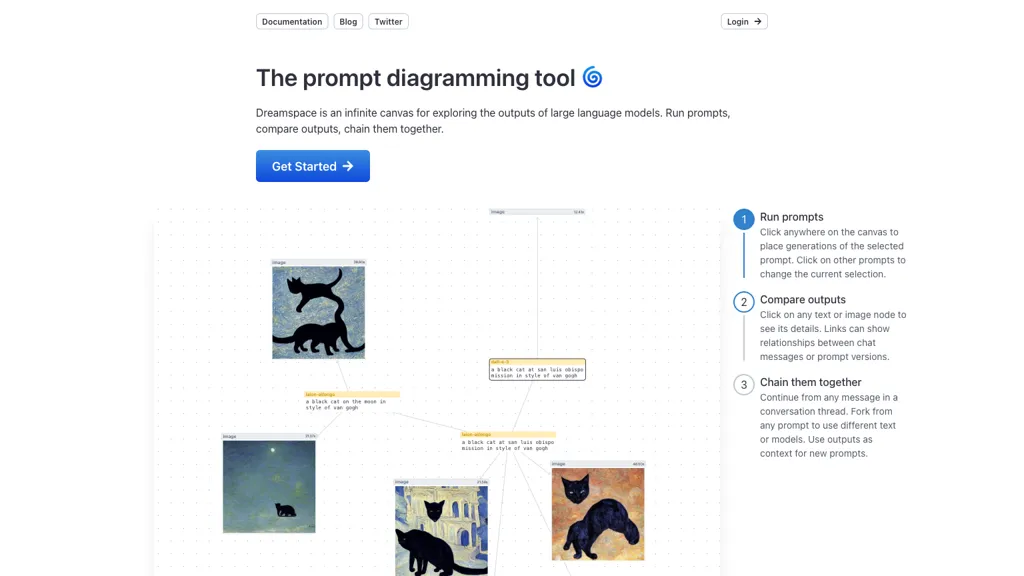What is Dreamspace?
Dreamspace.art is a next-generation diagramming tool, power-driven by large language models, generating output on an infinite canvas. It allows users to enter anything that comes into their minds, compare the different outputs with one another, and seamlessly chain them together. Its strong features, including node and edge manipulation, enhance its interactive and user-friendly nature.
Key Features & Benefits: Dreamspace
Powered by large language models, for smart diagramming. Generates outputs on an infinite canvas to leave room for creativity. Run multiple prompts for many different possibilities. Compare a lot of outputs to help refine your ideas. Supports chaining outputs to continue the workflow seamlessly. All these features bring several advantages in terms of increased creativity, fast design versions, and collaboration. The unique selling point that Dreamspace has to offer is the transforming text prompts to visually aesthetic diagrams, saving time and effort of manual design processes.
Dreamspace Use Cases and Applications
Dreamspace.art can be used in many ways across various industries. Here are some specific examples:
-
Mind Maps and Flowcharts:
Make interesting mind maps and flowcharts by simply inputting text prompts, therefore focusing all attention on creativity and idea generation. -
Design Iteration:
Freelance design concepts quickly by pitting a number of prompts against each other, comparing their outputs, and easily chaining them together. -
Collaboration and Brainstorming:
Enhance collaboration and brainstorming with node and edge manipulation features to interact and customize diagram outputs in real-time, promoting teaming and creativity in projects. It’s particularly useful for data scientists, designers, writers, content creators, teachers, and project managers.
How to Use Dreamspace
Using Dreamspace.art is not that hard. Here is how to go about it, step by step:
- First, sign up on Dreamspace.art.
- Log in now and be greeted by the infinite canvas interface.
- Type your text prompts here. Run prompts and read the output. Experiment with different outputs, combining them if necessary.
- Make use of node and edge manipulation features to further make your own diagram outputs interesting for your needs.
- For best results, try different prompts and explore the several customization options available.
How Dreamspace Works
Dreamspace.art runs on advanced large language models that interpret text prompts to generate diagram outputs. Inbuilt sophisticated algorithms and models are used to ensure accuracy and aesthetic appeal of results. Workflows can involve simply inputting a prompt and generating an output, then further iterating or chaining outputs as required in an infinite canvas environment.
Dreamspace Pros and Cons
Similar to any tool, there are a host of advantages and probable weaknesses that characterize Dreamspace. Some of these include the following:
-
Pros:
- Allows for creative diagram generation efficiently.
- Offers real-time collaboration and brainstorming.
- Chaining outputs, seamless workflow.
-
Cons:
- There may be some learning curve involved for the first-time user.
- Quality of output is as good as the input prompt provided.
Overall, user feedback focuses on the ease of use and brilliant features that make it the most productive and creative tool.
Conclusion about Dreamspace
In a nutshell, Dreamspace.art is really a great diagramming tool leveraging large language models to draw diagrams effectively and creatively. Its key features and benefits make it an invaluable asset for many different types of users, from data scientists to designers and educators. Though it has some potential drawbacks, the overall user experience and innovative capabilities make it very competitive in the diagramming tools markets. Further updates and developments will only prove to be beneficial.
Dreamspace FAQs
Q: What is Dreamspace.art?
A: A diagramming tool using large language models to provide an output on an infinite canvas.
Q: Who could use Dreamspace?
A: This tool will be very helpful for data scientists, designers, writers, all kinds of content creators, educators, and project managers—really, anyone who needs to make a diagram.
Q: How does Dreamspace.art work?
A: It runs through advanced large language models that understand the text prompts and produce diagram outputs, which one can chain and customize seamlessly.
Q: What are some of the drawbacks to using Dreamspace?
A: Generally user-friendly, but new users may face a little learning curve, and quality at par with inputs is as good as the output.









